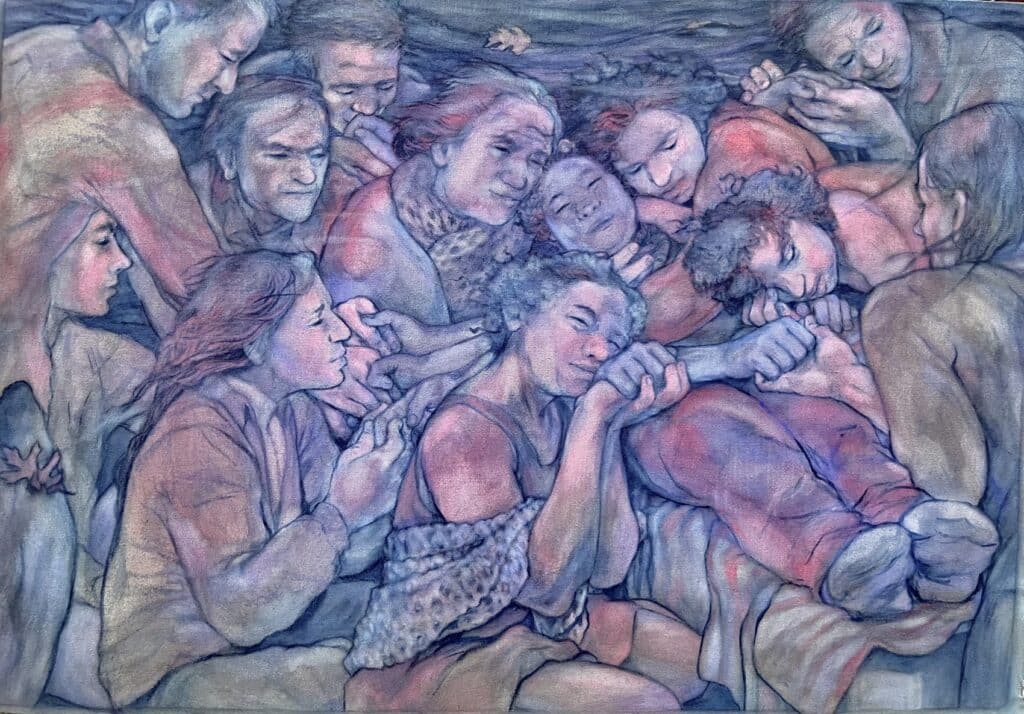The Art of a Good Death
November 7, 2025
National Art Exhibition Inspires Canadian Artists to Reimagine the End of Life

What does it mean to die well? A groundbreaking new national art competition and its associated exhibits are bringing this age-old question into the spotlight, and into Canadian galleries and public spaces.
In a culture that often shies away from talking about death, The Art of a Good Death breaks the silence with creativity, courage and compassion. This powerful exhibition doesn’t just ask how we die, but how we live, connect, and care for each other at the end. Through the eyes of artists, the most difficult conversations become not only possible, but beautiful.
“Art is such a powerful medium for communication both in terms of sharing research findings with viewers and sparking dialogue,” said Sarina Isenberg, Associate Professor in the Department of Medicine and the School of Epidemiology and Public Health at the University of Ottawa and Chair in Mixed Methods Palliative Care Research at Bruyère Health Research Institute, whose Lab hosted the competition, “Our hope with this project was to bring research on death and end-of-life care into the public sphere through leveraging art to inspire reflection, conversation, and action.”
Thanks to funding from the Canadian Institutes of Health Research (CIHR), this initiative offers a unique opportunity to transform academic research on death and dying into art that informs, inspires, and starts conversation. The national Good Death Art Competition asked artists across the country to interpret research about end-of-life care and what it means to ‘die well’ through visual art. Now, three powerful works have been selected from more than 100 submissions from artists spanning nine provinces across Canada, each offering a profoundly moving reflection on life’s final chapter.
“Palliative care is a deeply human and cross-cutting health issue that affects us all—yet conversations about death and dying often remain on the margins. As a palliative care physician, I have seen firsthand how important it is to create space for these difficult but essential discussions,” said Dr. Paul Hébert, President, Canadian Institutes of Health Research. “The Art of a Good Death is a powerful example of how art can bring these essential topics to the fore with empathy, creativity, and impact. This initiative shows how research can be made accessible and emotionally resonant, bridging the gap between science and society. At the Canadian Institutes of Health Research, we are proud to support innovative knowledge mobilization approaches like this one. I am especially pleased to see the leadership of my colleague, Dr. Sarina Isenberg, whose work is advancing how we understand and support end-of-life care. Congratulations to the research team and participating artists—your work is helping to transform how we think, feel, and talk about end-of-life care.”
Meet the Winners and Runners Up:
- Category: Creativity in Communicating Research
- Winner: Jennifer Kershaw (Ontario) for “In Excelsis Doughnut”
- Runner Up: Barbara Brown and Cynthia O’Brien (Ontario) for “Body and Spirit”
- Category: Effectiveness in Communicating Research
- Winner: Susan McLeod (Nova Scotia) for ‘I’m OK”
- Runner Up: Julie LeGal (Québec) for “…how I die…Die Faehre”
- Category: Authenticity in Reflecting Lived Experience
- Winner: Aimee-Rose Philibert (British Columbia) for (Vent de Melisse)
- Runner Up: Erica Tripp (Ontario) for (Sorry For Your Loss)
A jury of art curators, health services researchers, healthcare providers, and caregivers with lived experience rated entries independently using pre-determined selection criteria according to the creativity and effectiveness in communicating the research, and authenticity in reflecting lived experience. Winning artists will each receive a $1,000 prize and travel to Ottawa for the official launch and vernissage of The Art of a Good Death exhibition at the Ottawa Art Gallery on Monday 24 November, 2025 at 5:00pm.
“At the Ottawa Art Gallery, we see firsthand the power of the collaboration between the arts and health sectors,” said Alexandra Badzak, Director and Chief Executive Officer, Ottawa Art Gallery. “We’re proud to partner on A Good Death, a project that uses art to make a difference, shift perspectives, and inspire change. Using creative tools in a research capacity helps transform complex topics into something people can truly connect with. When it comes to important matters like end-of-life care, these partnerships raise public and professional awareness, encourage reflection, and ultimately improve care.”
The winning pieces, and runners-up, will debut in a special exhibition at the Ottawa Art Gallery from November 8, 2025 to January 11, 2026, before embarking on a national tour through hospitals, hospices, and art spaces across the country. The full collection, including the top entries from artists from across the country, will also be featured in a digital gallery at www.isenberglab.com.

Facebook
Twitter
LinkedIn
Email




